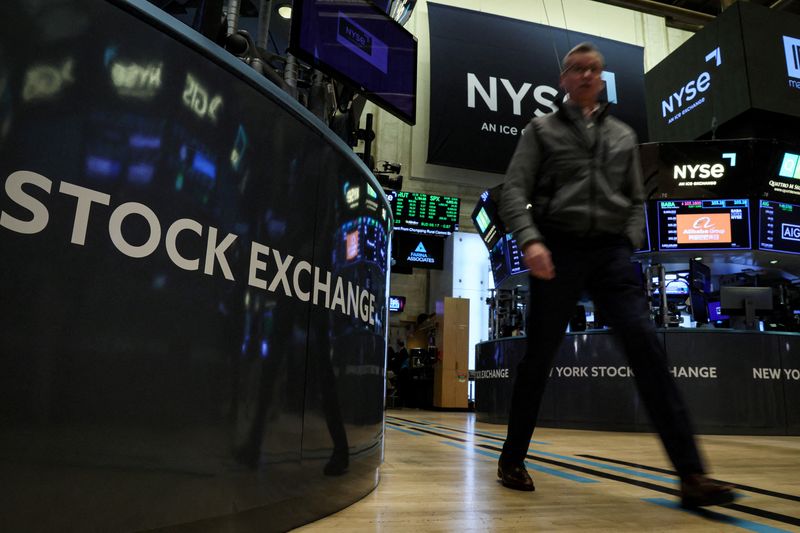Wall Street closes lower after Fed minutes, inflation data

© Reuters. FILE PHOTO: Trader works on the floor of the New York Stock Exchange (NYSE) in New York City, U.S., March 30, 2023. REUTERS/Brendan McDermid/File Photo
US500
-0.41%
Add to/Remove from Watchlist
Add to Watchlist
Add Position
Position added successfully to:
+ Add another position
Close
DJI
-0.11%
Add to/Remove from Watchlist
Add to Watchlist
Add Position
Position added successfully to:
+ Add another position
Close
C
-0.59%
Add to/Remove from Watchlist
Add to Watchlist
Add Position
Position added successfully to:
+ Add another position
Close
JPM
-0.02%
Add to/Remove from Watchlist
Add to Watchlist
Add Position
Position added successfully to:
+ Add another position
Close
WFC
-0.46%
Add to/Remove from Watchlist
Add to Watchlist
Add Position
Position added successfully to:
+ Add another position
Close
IXIC
-0.85%
Add to/Remove from Watchlist
Add to Watchlist
Add Position
Position added successfully to:
+ Add another position
Close
AAL
-9.22%
Add to/Remove from Watchlist
Add to Watchlist
Add Position
Position added successfully to:
+ Add another position
Close
By Stephen Culp
NEW YORK (Reuters) – U.S. stocks ended lower on Wednesday after minutes from the Federal Reserve’s March policy meeting revealed concern among several members of the Federal Open Markets Committee (FOMC) regarding the regional bank liquidity crisis.
The minutes followed a cooler-than-expected inflation report which belied stickier underlying data and cemented the likelihood of another policy rate hike when the Fed convenes next month.
All three major U.S. stock indexes seesawed throughout the session to close in negative territory.
“The minutes were clear that there’s ongoing Fed concern with respect to the banking crisis as well as elevated prices,” said Greg Bassuk, chief executive officer of AXS Investments in New York.
The indexes started gyrating as market participants parsed the Labor Department’s Consumer Price Index (CPI).
That report, on prices urban consumers pay for a basket of goods and services, came in below analysts’ expectations, suggesting that the Fed’s efforts to tame inflation is taking effect.
However, core CPI – which strips out volatile food and energy items – hit the consensus bull’s eye, and remains well above the Fed’s average annual 2% target rate.
Inflation https://www.reuters.com/graphics/USA-STOCKS/zdvxdaxexvx/inflation.png
“This week is an inflection point as investors are searching for surer footing in advance of corporate earnings and the PPI (producer prices) report coming out tomorrow,” Bassuk said.
“(Economic) data has been very mixed so investors are overacting to any positive or negative hint of Fed rate hike policy. Volatility will continue, investors will have to buckle their seatbelts. There’s so much going on now causing uncertainty for both Wall Street and Main Street.”
At last glance, financial markets have priced in a 70% likelihood of another 25 basis point interest rate hike at the conclusion of the FOMC’s policy meeting next month.
The next market-moving catalyst is likely to be first-quarter earnings season, which kicks off on Friday with results from three big banks – Citigroup Inc (NYSE:C), JPMorgan Chase & Co (NYSE:JPM) and Wells Fargo (NYSE:WFC) & Co.
Analysts now expect aggregate first-quarter S&P 500 earnings down 5.2% year-on-year, a stark reversal from the 1.4% annual growth seen at the beginning of the quarter.
The Dow Jones Industrial Average fell 38.29 points, or 0.11%, to 33,646.5; the S&P 500 lost 16.99 points, or 0.41%, at 4,091.95; and the Nasdaq Composite dropped 102.54 points, or 0.85%, to 11,929.34.
Among the 11 major sectors of the S&P 500, seven ended in negative territory, with consumer discretionary suffering the largest percentage loss. Industrials led the gainers.
American Airlines (NASDAQ:AAL) Group Inc slid 9.2% after it forecast a lower-than-expected first-quarter profit.
Declining issues outnumbered advancers on the NYSE by a 1.08-to-1 ratio; on Nasdaq, a 1.69-to-1 ratio favored decliners.
The S&P 500 posted 12 new 52-week highs and two new lows; the Nasdaq Composite recorded 64 new highs and 187 new lows.
Volume on U.S. exchanges was 10.40 billion shares, compared with the 11.78 billion average over the last 20 trading days.